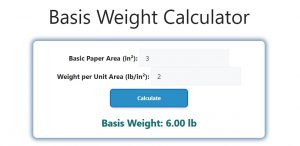About Basis Weight Calculator (Formula)
A Basis Weight Calculator is a valuable tool in the paper industry, helping manufacturers, printers, and consumers determine the weight of paper based on its size and type. Basis weight refers to the weight of a specific area of paper, typically measured in pounds per ream (500 sheets) for sheets measuring 24 inches by 36 inches. Understanding basis weight is crucial for selecting the right paper for printing, packaging, and other applications, ensuring quality and cost-effectiveness.
Formula
The formula for calculating basis weight is: Basis Weight = Basic Paper Area * Weight per Unit Area. In this formula, the basic paper area is typically measured in square feet, and the weight per unit area is measured in pounds per square foot.
How to Use
Using a Basis Weight Calculator is straightforward:
- Determine Basic Paper Area: Measure the dimensions of the paper (length and width) in feet to calculate the area.
- Find Weight per Unit Area: Check the weight per unit area of the paper, which can usually be found on the manufacturer’s specifications or product label.
- Input Values: Enter the basic paper area and weight per unit area into the calculator.
- Calculate Basis Weight: Click the “Calculate” button to find the basis weight of the paper.
Example
Let’s calculate the basis weight of a sheet of paper that measures 2 feet by 3 feet and has a weight per unit area of 0.5 pounds per square foot.
- Calculate Basic Paper Area:
- Area = Length × Width = 2 ft × 3 ft = 6 sq ft.
- Weight per Unit Area: 0.5 pounds/sq ft.
Using the formula:
- Basis Weight = Basic Paper Area * Weight per Unit Area
- Basis Weight = 6 sq ft * 0.5 lbs/sq ft = 3 lbs.
Thus, the basis weight of this paper is 3 pounds.

FAQs
- What is basis weight?
Basis weight refers to the weight of a specific area of paper, typically expressed in pounds for a ream of 500 sheets at a specified size. - Why is basis weight important?
Basis weight is crucial for determining the thickness, sturdiness, and suitability of paper for various applications, such as printing and packaging. - How is basis weight measured?
Basis weight is measured by calculating the weight of a ream of paper (500 sheets) in pounds, based on its area. - What does a higher basis weight indicate?
A higher basis weight indicates thicker, denser paper, which may be more suitable for high-quality printing or packaging. - Can basis weight vary for the same size paper?
Yes, basis weight can vary depending on the type of paper and its weight per unit area, even for the same dimensions. - How do I find the weight per unit area of paper?
The weight per unit area can often be found on the product label or manufacturer’s specifications for the paper type. - What are common basis weight values?
Common basis weight values include 20 lb, 24 lb, 28 lb, and 80 lb for various types of paper. - Is basis weight the same as grammage?
No, basis weight is usually expressed in pounds for a specific size, while grammage is expressed in grams per square meter (gsm). - How can I calculate basis weight for different paper sizes?
Use the same formula, adjusting the basic paper area based on the dimensions of the paper you are measuring. - Does basis weight affect printing quality?
Yes, the basis weight can influence the quality of printing, ink absorption, and durability of the final product. - What type of paper has the highest basis weight?
Cardstock and specialty papers typically have higher basis weights compared to standard copy paper. - Can I use the basis weight calculator for non-paper materials?
While designed for paper, similar principles can be applied to other materials with known area and weight per unit area. - How does moisture affect basis weight?
Moisture can affect the weight of paper, making it heavier when damp; thus, calculations should be done with dry paper for accuracy. - What is the difference between basis weight and actual weight?
Basis weight is a standardized measure, while actual weight refers to the total weight of a specific batch or ream of paper. - Can I measure basis weight with a scale?
Yes, by weighing a ream of paper and calculating its area, you can determine the basis weight manually. - How does paper thickness relate to basis weight?
Generally, thicker paper has a higher basis weight, but this can vary based on the paper’s composition and type. - What industries rely on basis weight calculations?
Industries such as printing, publishing, packaging, and manufacturing commonly use basis weight calculations for paper selection. - What happens if I use paper with the wrong basis weight?
Using paper with an incorrect basis weight can lead to issues like printer jams, poor print quality, or structural failure in packaging. - Can I find a basis weight calculator online?
Yes, numerous online tools and calculators can assist with quick basis weight calculations based on your input values. - What other factors should I consider when choosing paper?
In addition to basis weight, consider factors such as paper finish, texture, opacity, and brightness for your specific needs.
Conclusion
A Basis Weight Calculator is an essential tool for anyone working with paper, whether for printing, packaging, or other applications. By understanding how to calculate basis weight and its importance, users can make informed decisions when selecting the appropriate paper for their projects. With the right knowledge and tools, achieving quality results in paper-related tasks becomes easier and more efficient.